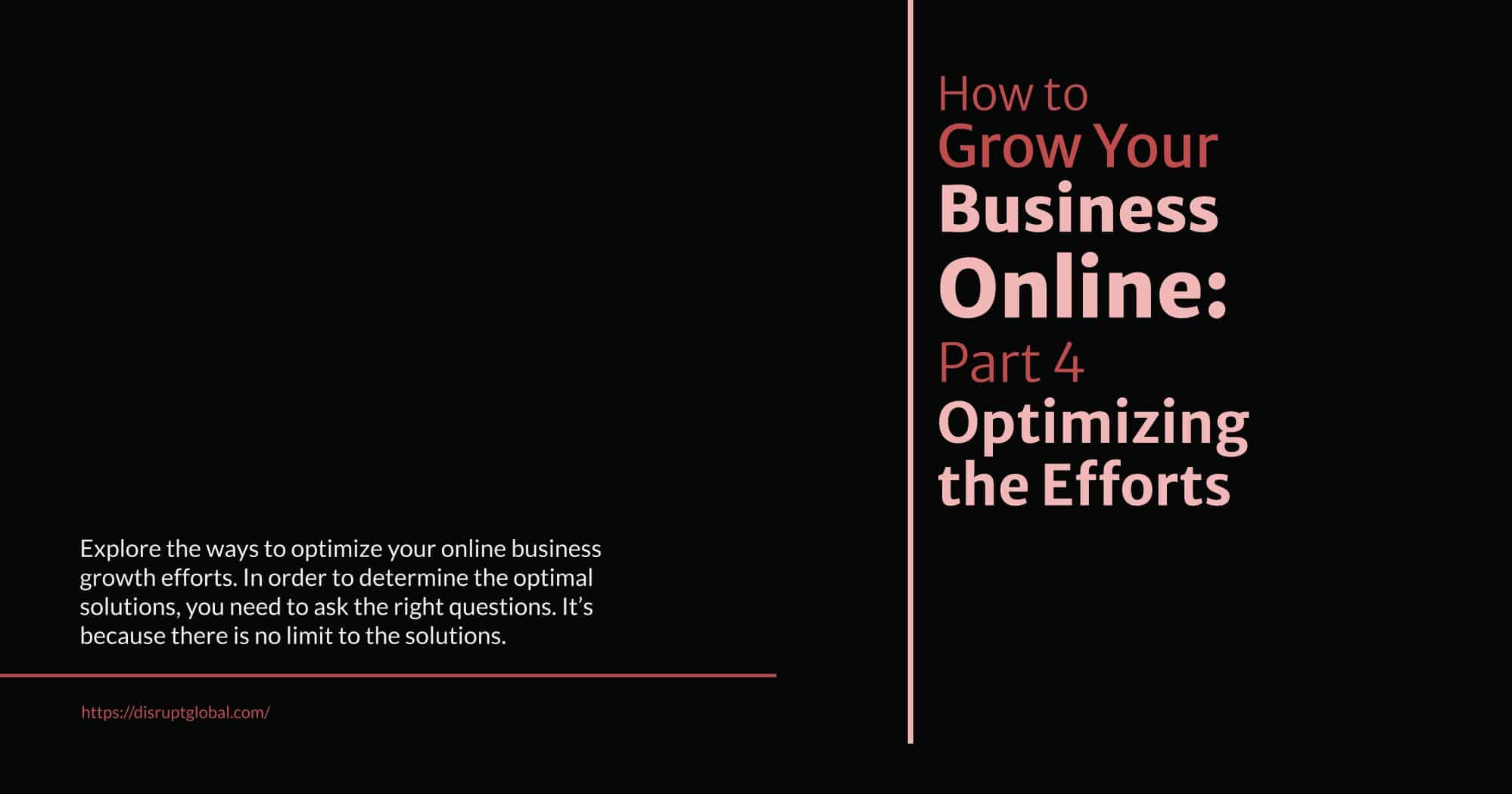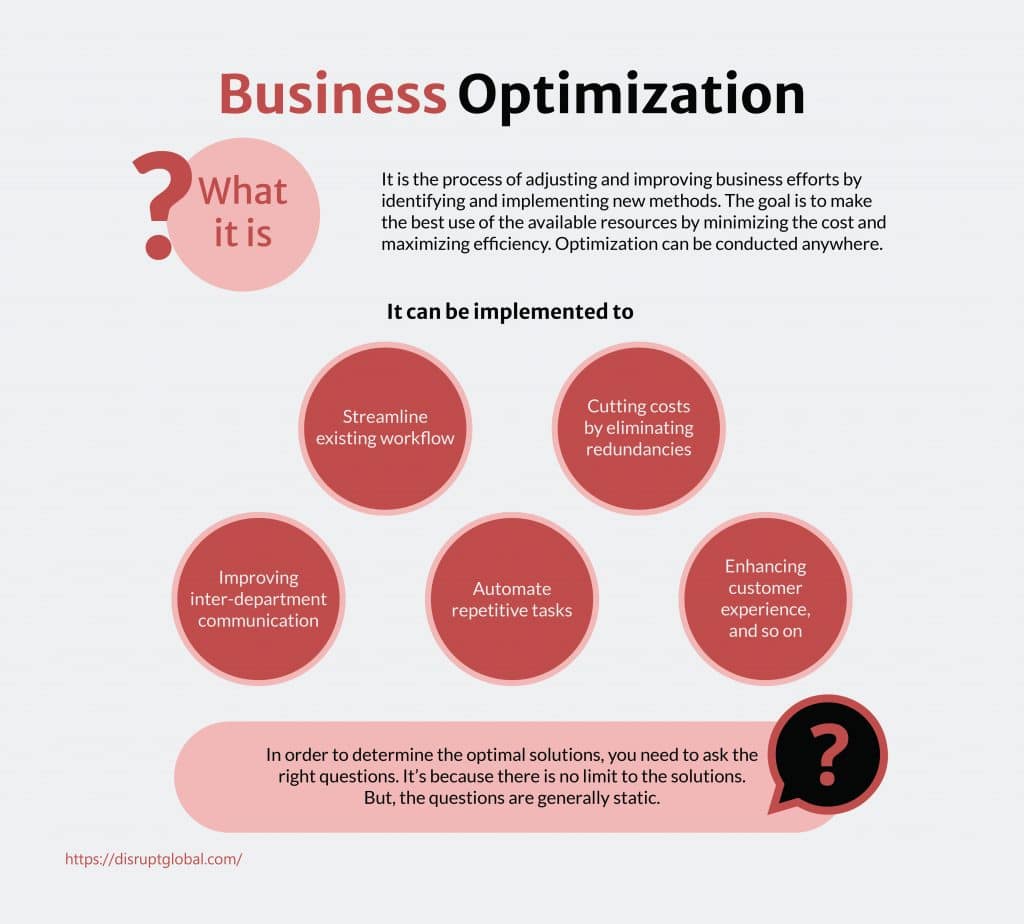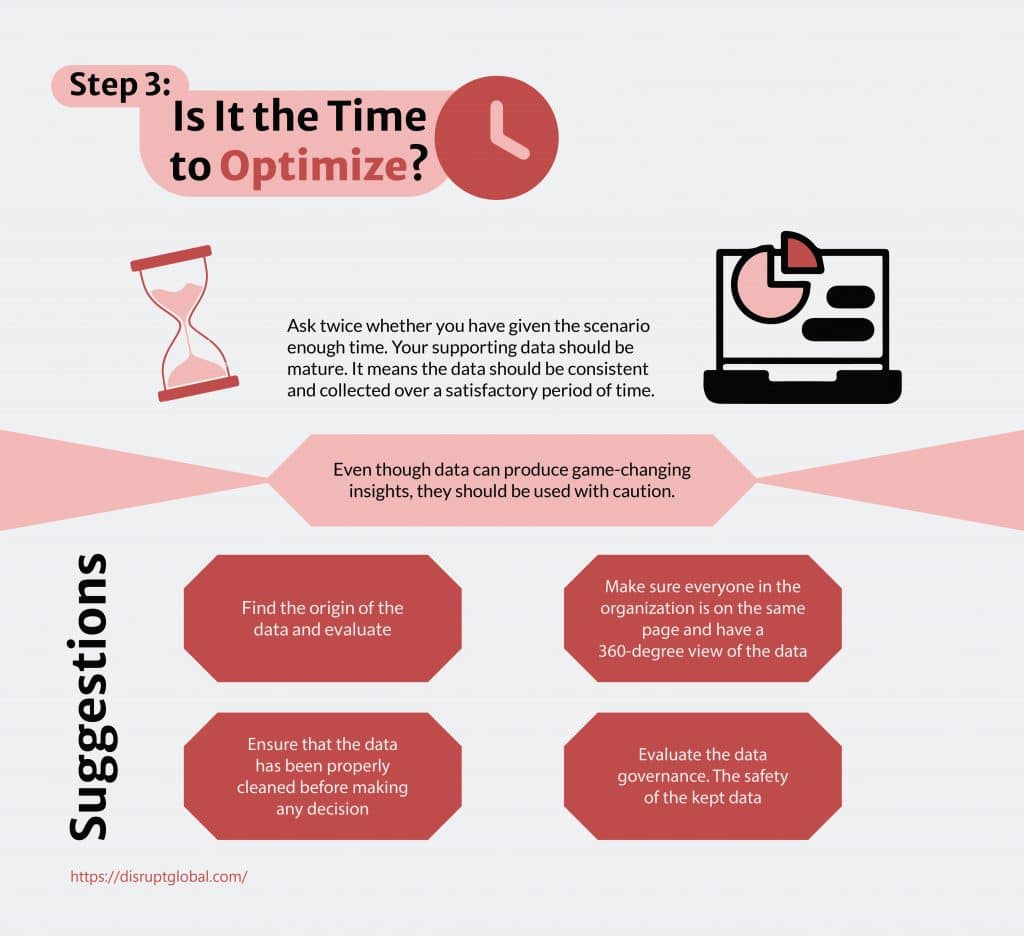
How to Grow Your Business Online: Part 4 – Optimizing the Efforts
Posted by. Disrupt Tech. March 5, 2022
This is the 4th part of the How to Grow Your Business Online series. In part 1, 2, and 3, we discussed market research, ways to drive customers, and tracking and analyzing the data.
Today, we are going to explore the ways to optimize your online business growth efforts. Without further ado, let’s begin.
So, what is Business Optimization?
Well, Business Optimization is the process of adjusting and improving business efforts by identifying and implementing new methods. The goal is to make the best use of the available resources by minimizing the cost and maximizing efficiency. Optimization can be conducted anywhere. It can be implemented to
* Streamline existing workflow,
* Cutting costs by eliminating redundancies,
* Improving inter-department communication,
* Automate repetitive tasks,
* Enhancing customer experience, and so on.
In order to determine the optimal solutions, you need to ask the right questions. It’s because there is no limit to the solutions. But, the questions are generally static. Thus, we will focus on asking the right questions.
Below are the must-have questions that you need to ask for optimizing your business efforts –
Step 1: Again, What is the Most Important Outcome?
First off, find what is the most important result for you. Be it your email campaign or social media campaign or anything – all your online campaigns should have a common goal. The individual channels are just separate pieces of your overall strategic objective.
Finding what you are trying to achieve will help you tweak your campaigns around different channels to meet your ultimate goal.
Step 2: What is the Tangible Problem?
If you have done part 3 right, you now have the metrics available to you. After doing the analysis, you need to find your problems. Ask what particular problem/s are you seeking to solve?
When you get the answer, redefine the problems tangibly. It means, the answer to the questions should be straightforward. They should be typically answered with yes/no.
Another thing to keep in mind that percentages are great. However, you need to relate the actual figure too. Without proper historical contexts and actual figures, percentages like conversion rate lifts will not do much help.
Step 3: Is It the Time to Optimize?
Ask twice whether you have given the scenario enough time. Your supporting data should be mature. It means the data should be consistent and collected over a satisfactory period of time. Do your data deserve the trust?
Even though data can produce game-changing insights, they should be used with caution. Here are some suggestions –
* Find the origin of the data and evaluate.
* Ensure that the data has been properly cleaned before making any decision. Redundant data for example can generate a false trend.
* Does the data provide a complete view? Make sure everyone in the organization is on the same page. All of you involved in the decision-making process should have a 360-degree view of the data
* Evaluate the data governance. Have the data been kept safe?
Step 4: How can Improve Our Conversion Rate?
At the end of the day, it’s all about optimizing your conversion. Optimizing the conversion rate is the easiest way to make a profit. But, first, let’s back up a bit and fully understand what conversion is.
Conversion doesn’t only mean sales. Sales could be your ultimate conversion event, but there are other metrics as well. For example, visiting the website or landing page, generating leads, and so on. In most cases, the total amount of sales is the targeted conversion event.
We have already defined our desired outcome in step 1. Simply put, the conversion rate is the rate of achieving that outcome. So, it’s the number of desired out divided by the number of prospects.
Optimizing your conversion rate thus guarantees to optimize your most important outcome or campaign goal.
Now, how do you do that?
Conversion rate optimization often doesn’t require any innovation. Most of the time, it’s not about new solutions. It’s about finding out what’s not working and fixing it. So, everything is already there. You just have to detect it and fix it.
Let’s briefly go over the CRO tactics –
1. A/B Testing
So the first step is to find where you need to work on? Does your product/service have any problem? Or, is it about the user experience?
In simple terms, A/B testing is splitting the variable (for example, your website layout) into equal groups. And then, testing them equally. Here, the key is that there should be only one variable at a time.
See how former US president Barack Obama raised 2.8 million more email addresses and $60 Million by leveraging the power of A/B testing. A great case study!
2. Why Me?
Why would the customers buy from you and not your competitors? Analyze your customer value proposition. Analyze your marketing funnel. For each step, try to optimize their journey. An optimized Customer Value Proposition helps the customer to move to the next step of the journey. Ask 3 questions –
a. Is my CVP short and clear enough?
b. Is there a powerful value statement?
c. Are you offering something unique?
3. Optimizing Communication
It’s the simplest of all. Yet, people often mess it up. Think! You are continuously communicating with your customers/prospects. Are you using your colloquial language? Or, do you become a different person with your keyboards?
Don’t make your customers want to hit their heads against a brick wall. Don’t confuse them with complex words and jargon. They have enough on their plate already. Make it easy for them to understand instead of trying to sound smart and sophisticated.
The trick is to talk to them, instead of writing to them.
4. Reducing Choices
Yes, that’s right. Consumers of 2021 have to make too many decisions in a day. When you offer too many choices, other than increasing your cost, you are creating more emotional loads for them. It will eventually result in no decision-making at all.
It’s called the paradox of choice. The paradox of choice leads to analysis paralysis, where your customers become paralyzed by overthinking.
If you want to learn more about why reducing the choices helps, you can read the jam study.
Here, playing the urgency trick can help. It works by creating a scarcity of time and/or supply. But never fake it. People are not stupid. If they understand that you are faking it, they will leave you without thinking twice.
To Sum up
So, the mantra to optimize your business is to define the most important outcome and the problem. Then, observing and analyzing the customer journey. Use data to find out where’s the friction. Find out why they are not converting. Test your hypothesis and your solutions. Once you are sure about the solution, implement it.



